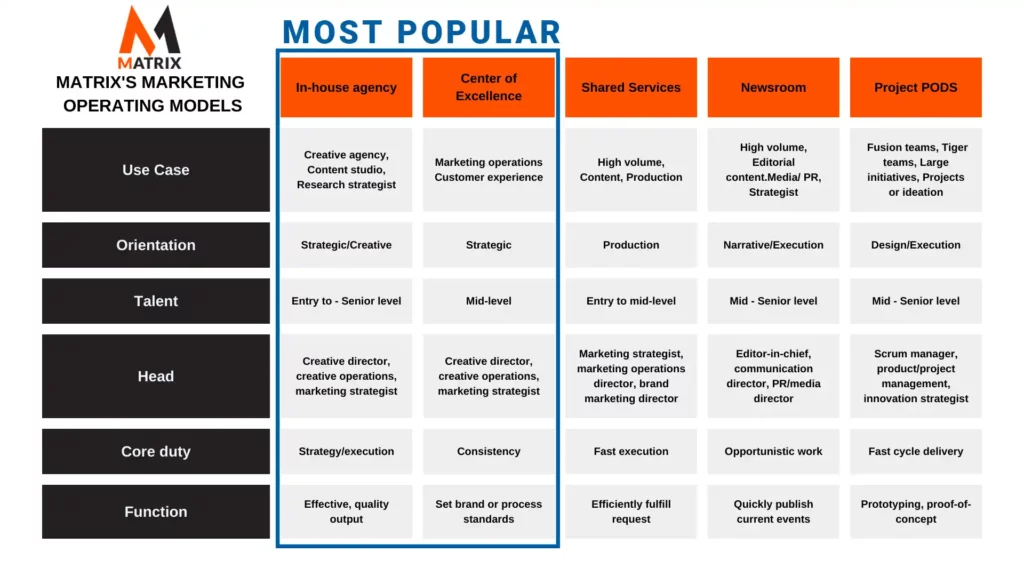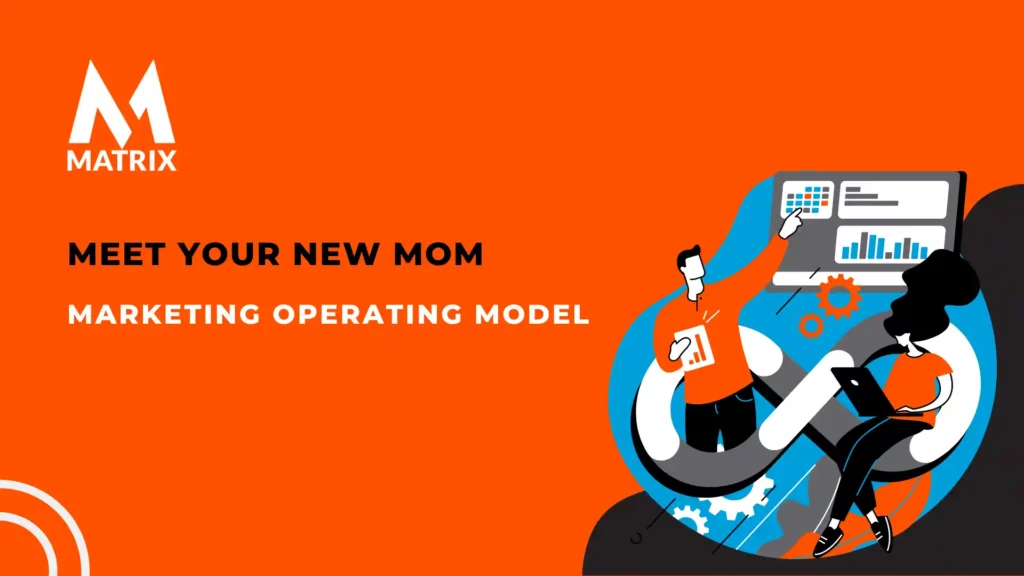Introducing your new go-to for modern marketing – MOM, short for ‘Modern AI Marketing Operating Model.’
As businesses strive to optimize budget spend and achieve goals, the AI Marketing Operating Model (MOM) has emerged as an indispensable solution for streamlining marketing efforts.
To drive revenue growth in the digital age, new data shows that marketing leaders are upgrading data-collection technology, collaborating closely with IT, and focusing on test-and-learn agile marketing operating model.
Modern marketing requires a new and improved operating model as the digital age progresses. MOM provides structure and insight into key activities essential for successful marketing processes.
This blog post will explore the benefits of having a MOM in place and provide tips on how businesses can start using this proven approach.
Artificial intelligence (AI) plays an increasingly critical role in the rapidly evolving marketing world. A new AI-driven marketing operating model is emerging, integrating technology and data with human creativity and strategic thinking. Denver Digital Marketing Agencies are Failing Their Clients.
Why the Marketing Operations Model Must Go AI-Native
Marketing operations are at a crossroads. As customer expectations accelerate and marketing ecosystems become more complex, traditional operating methods are falling behind.
Most marketing ops teams are still managing campaigns manually, stitching together insights from disconnected tools, and reacting to lagging indicators. The model is rigid, slow, and optimized for a world that no longer exists.
To compete today, CMOs and product leaders need a different kind of engine — one that’s intelligent, adaptive, and autonomous. This is where the AI-native marketing operations model enters. Unlike AI-assisted platforms that add intelligence on top of legacy infrastructure, AI-native systems are built from the ground up to act, learn, and optimize at scale.
They respond to behavior in real time, generate insights proactively, and continuously improve campaigns without waiting for manual inputs.
| Category | Traditional Ops Model | AI-Native Ops Model |
|---|---|---|
| Campaign Execution | Pre-scheduled, static content calendars | Real-time, signal-driven activations |
| Audience Segmentation | Manual, persona-based groups | Dynamic, evolving behavioral clusters |
| Optimization Cycle | Monthly/quarterly A/B testing | Autonomous, multivariate experimentation |
| Insights & Analytics | Retrospective reports | Predictive alerts & recommendations |
The AI-native model also unlocks new levels of efficiency and performance. Marketing teams can redirect hours previously spent on manual tasks toward strategic activities like creative development, market expansion, and brand differentiation.
And the results speak for themselves — early adopters report up to a 60% increase in lead conversion and a 30% lower cost-per-acquisition, all while moving faster and more intelligently across channels.
| Metric | Before (Traditional) | After (AI-Native) |
|---|---|---|
| Conversion Rate | 2.1% | 3.5% – 5.4% |
| Time to Optimize | 3–6 weeks | 24–72 hours |
| Human Hours Spent | 60+ hours/month | < 10 hours/month |
| Cost Per Lead (CPL) | $320 | $190 |
Marketing operations no longer have to be the bottleneck — they can be the accelerator. But only if they’re re-engineered with intelligence at the core. This is the transformation that forward-thinking product managers and CMOs are now leading across industries.
Operational Impact Breakdown
Here’s a snapshot of what shifts when an organization transitions to AI-native marketing operations:
This new AI-driven operating model can be described in four key areas:
1. Data-Driven Insights:
AI is critical for managing and making sense of the vast amounts of data marketers now have. This data, drawn from diverse sources such as CRM systems, social media, website analytics, and third-party data providers, is analyzed to derive insights about customer behavior, preferences, and buying patterns. AI technologies like machine learning can identify patterns in large data sets that human analysts might miss.
2. Personalization at Scale:
One of the biggest advantages of using AI in marketing is the ability to provide personalized experiences at scale. Using AI, businesses can tailor the customer experience to individual preferences and behaviors, providing personalized product recommendations, content, and messages. This level of personalization can help increase customer engagement, loyalty, and, ultimately, sales.
3. Predictive Analytics:
AI is also helping marketers look to the future. Through predictive analytics, AI can forecast future customer behavior, market trends, and sales, helping businesses to plan effectively. Whether it’s predicting which customers are most likely to churn or which are most likely to make a purchase, AI helps marketers be more proactive and strategic.
4. Automation and Efficiency:
AI-driven marketing technologies automate many routine tasks, freeing marketers to focus on more strategic initiatives. Whether it’s automating email campaigns, social media posts, or PPC bid management, AI is helping to increase efficiency and reduce costs. Furthermore, AI chatbots and virtual assistants enhance customer service by responding instantly to customer queries.
5. Enhanced Creativity:
AI doesn’t replace creativity; rather, it enhances it. By handling data analysis and routine tasks, AI frees marketers to focus on the creative aspects of their roles. AI can also provide insights and inspiration for creative decisions. For instance, AI can analyze which types of content perform best, informing future content creation. Content Translation Services: A Competitive Advantage for Your Business
The marketer’s role is evolving in the new AI-driven marketing operating model. Marketers must be comfortable working with technology, interpreting data, and applying AI-driven insights to their strategic decisions. At the same time, the importance of creativity and strategic thinking is more critical than ever, as these are skills that AI cannot replace. The result is a more effective, efficient, and personalized approach to marketing that delivers better results.
Are you looking for a way to optimize your marketing efforts and budget spending?

The Marketing Operating Model (MOM) is quickly becoming an invaluable tool for businesses that want to stay ahead of the competition in the digital age. It provides structure and insight into key activities, allowing marketers to make smarter decisions, better allocate resources, and gain greater control over their strategies.
With MOM, you can streamline your marketing efforts, optimize budget spending, and achieve business goals faster than ever. You’ll be able to keep up with the latest trends in digital marketing while staying on top of data-collection technology, collaborating closely with IT teams, and focusing on test-and-learn agility.
Read this blog post to learn more about how MOM can help your business succeed!
Poor Marketing ROI

In 2022, poor marketing ROI will become even more of a problem for businesses as companies need help to balance their marketing budget with an increasingly complex digital landscape. According to surveys from major consumer and business services firms, the number of companies reporting a negative return on their marketing investments has grown by almost 10%. How to Create a Revenue Strategy in 7 Easy Steps
At the same time, research shows that the average cost per conversion is rising. On average, businesses spend 30% more on marketing than in 2024, yet conversions from paid search campaigns have decreased by 10%. Poor targeting decisions have caused many businesses to waste money on ineffective ads that don’t reach their intended audience.
In addition, the proliferation of digital channels has made it increasingly difficult for marketers to track and measure their results accurately and timely. Traditional methods of tracking ROI, such as clicks and impressions, are becoming obsolete. In contrast, many marketers still need to discover more sophisticated metrics, such as lifetime value (LTV) and customer loyalty.
The good news is that there is hope. By investing in Marketing Operating Model solutions such as data-driven decision-making tools, sophisticated analytics software, and automation technology, businesses can reduce wasteful spending and maximize returns on marketing investments.
Companies with a clear understanding of their target market can use predictive analytics to anticipate customer needs before launching costly campaigns, create personalized content, and utilize new technologies like voice search optimization for better SERP rankings.
In this way, organizations can drive long-term growth through improved customer engagement—ultimately leading to higher ROI from their marketing initiatives.
External trends tell us that digital buyer is unpredictable in their past buying behaviors.
Unpredictable digital buying behaviors

Modern marketing requires a new digital operating model that can help address the challenge of dealing with unpredictable buyers. In today’s marketplace, customers are more likely to make decisions based on the latest trends and technologies. This means marketers must be more agile and flexible when creating strategies to reach their target audience.
One way to address this challenge is to use a new marketing ops model (MOM). This effective management tool helps define key activities, structures, and processes related to marketing efforts. The MOM gives marketers unprecedented insight into how customers interact with their brand across all channels, allowing them greater control over their campaigns. What are Digital Marketing Services?
The MOM also allows companies to track customer behavior in real time, enabling them to adjust campaigns quickly based on emerging trends or changes in customer preferences.
With this data, marketers can identify potential opportunities for strategic growth and risks associated with certain activities. It also provides a bird’s-eye view of how different marketing efforts perform against competitors, allowing marketers to allocate their budget and resources better for optimal impact.
In addition, the MOM enables marketers to gain visibility into procurement and operations activities to ensure that costs stay within budget and maximize returns on investment (ROI).
It also allows for better collaboration between departments so that teams can work together towards achieving objectives faster and more efficiently. Finally, the MOM helps companies identify areas where they may need to take advantage of potential revenue sources or opportunities for cost savings.
Overall, having a well-defined MOM is crucial for modern businesses seeking success in today’s fast-paced market environment. Companies should start by understanding their marketing strategy’s goals and defining clear objectives before setting up a robust structure based on those goals.
To achieve superior performance and growth, the CMO must craft a digital ecosystem that delivers value to customers.

Creating a digital customer value ecosystem to deliver performance and growth involves developing an effective marketing ops model to track customer behavior in real time and adjust campaigns accordingly.
The MOM should also provide visibility into procurement and operations activities to ensure resources are allocated efficiently while enabling better collaboration between departments. In addition, it should help companies identify areas of potential revenue sources or opportunities for cost savings.
Companies can understand their marketing strategy goals and objectives before developing the infrastructure. Finally, they must optimize customer experiences across all channels so buyers receive maximum value from their purchase decisions.
Burdensome cross-functional complexity is found in multi-unit business models.
Companies today face increasing complexity when managing multiple units. This can be especially taxing for marketing departments, which often manage multiple channels and cross-functional teams. The lack of visibility into the interdependencies of different organizational roles and functions can lead to inefficient resource use and difficulty achieving measurable results.
Cross-functional complexity results from the increased specialization and fragmentation of traditional marketing roles. As technologies become more advanced, there is now a need for more specialized skill sets that extend beyond the traditional marketing role.
For example, search engine optimization (SEO) requires expertise in digital analytics, web development, keyword research, content writing, and marketing automation, all separate but related skill sets. With clear visibility into how these tasks fit together and who is responsible for what, this complexity can lead to clarity among teams and prolonged decision-making processes due to misaligned objectives or a lack of coordination between parties.
Additionally, siloed communication channels can further complicate matters as stakeholders may only sometimes be aware of each other’s goals or strategies.
As a result, initiatives are often executed without considering their effects on other parts of the business, leading to delayed progress or conflicting results. To address this challenge, companies must create an environment that encourages collaboration across functions and breaks down departmental silos by embracing cross-functional alignment.
The Marketing Operating Model provides structure to help make sense of this complex landscape by providing visibility into key activities and dependencies between tasks, such as optimizing budgets, measuring performance against KPIs, and managing resources across different channels.
Streamlining operations will drive better outcomes at lower costs. It offers organized oversight of marketing operations while enabling more efficient team collaboration.
It provides accurate data tracking tools that allow marketers to analyze trends across multiple touchpoints and make smarter decisions. By implementing MOMs, organizations can ensure their marketing efforts are aligned with their overall business goals.
Disruptive market and audience dynamics
You must optimize shifts for brand value to become relevant. The brand value will come from a personal connection to the individual who has the authority to make the purchasing or decision-making decision.
In addition, that organization must offer some functional benefits, which may be attributed to opportunity gain, pain relief, or other necessary actions.
Who is responsible for the marketing operating model?

The modern marketing ops model is a powerful tool that has the potential to help organizations streamline their marketing efforts, optimize budget spend, and achieve business goals. Responsibility for the MOM should rest with the organization’s Chief Marketing Officer (CMO) or Head of Marketing. This person should have a deep understanding of the company’s overall strategy and objectives and a clear view of how different organizational functions intersect with marketing and each other. The CMO should also be knowledgeable about existing processes and systems within the company that could be leveraged to support MOM implementation.
In addition to establishing ownership at the top level, each team responsible for specific components of MOM must be held accountable for their respective tasks and deliverables.
For example, marketing analytics teams must provide accurate insights into customer data so decisions can be made based on facts rather than assumptions; creative teams need to develop campaigns that align with organizational objectives; product teams should ensure their offerings are differentiated from competitors; and sales teams should understand how customers prefer to purchase products or services.
It’s important to note that a successful MOM requires tight collaboration across all departments involved to ensure seamless execution. Each team should have detailed knowledge of what they need to do and when they need to do it to meet key deadlines while still achieving desired results.
Regular check-ins between departments ensure that everyone is on track with their deliverables and provide an opportunity for feedback and course corrections if needed.
Ultimately, an integrated system in which everyone is accountable for their tasks will lead to greater efficiency and improved performance overall. HubSpot and Microsoft are great for this.
Disruptive market and audience dynamics block traditional pathways to brand value.
We can look across the marketing funnel and add contacts; I’ll call it awareness, consideration, decision, and brand value. We’ve already discussed the market disruption between awareness and consideration. Audience expectations occur between decision and brand value. Digital behaviors occur between decision and brand value. Let me give you statistics to support that thesis.
Trends in the awareness stage
- There are 1.6 times more companies globally than in 2000.
- The average lifespan of a company on the S&P 500 Index has decreased by 34% since 1965.
Trends in the consideration stage
- 53% of audiences say choosing a well-known brand today is less important than 3 years ago.
- 55% of the audience agrees that big corporations are to blame for many societal problems.
Trends in the decision stage
- 75% of audiences have searched online for information about a previously unfamiliar brand while shopping.
How to build up your MOM
A modern Marketing Operating Model (MOM) is an invaluable tool that helps businesses streamline their marketing efforts, optimize budget spend, and achieve business objectives. By providing structure and insight into key activities, MOMs enable organizations to make smarter decisions, better allocate resources, and gain greater control over their strategies.
To get started with creating a successful MOM for your business, there are several key steps you should take:
- Define the scope of the model—what areas does it cover? Who will be involved in each activity within it?
- Identify core activities – Map out all current processes, including customer acquisition techniques, campaigns used, etc., identify duplicate or no longer necessary tasks, and focus on optimizing time spent on more important activities.
- Set clear goals and KPIs. Establish what success looks like for different projects so that progress can be monitored accordingly.
- Develop internal collaboration systems—Ensure departments have seamless communication by setting up shared platforms such as Slack channels, where teams can share data quickly and easily without relying heavily on emails.
- Analyze data – Leverage big data tools to help inform future decision-making by gathering real-time insights into customer behaviors and trends, which can aid in predicting consumer needs.
- Establish reporting systems – Set up regular performance reviews to ensure everyone is informed of the latest results and processes that can be adjusted if they are less effective than expected.
- Optimize budget spending—Ensure that you are making the most of your financial resources by regularly reviewing successful campaigns and areas where money could be better allocated.
By following these steps, businesses can create a powerful MOM that helps them streamline their marketing activities, optimize spending, and reach their desired business objectives. It’s an invaluable tool for companies looking to stay competitive in today’s digital landscape. Furthermore, it provides structure and insights, enabling marketers to make smarter decisions and allocate resources better.
Creating a MOM can be time-consuming and involves a lot of trial and error, but when done effectively, it can provide a big return on investment for businesses in the long run. Setting up requires dedication, but it is worth the effort to gain improved efficiency and maximize success. With this in mind, if you still need to implement a MOM for your business, now is the perfect time to start!
Benefits of Having a Modern Marketing Operating Model.
The contemporary marketing operations model is an invaluable tool. It aids companies in streamlining their marketing efforts, optimizing budget spend, and achieving business goals easily. This comprehensive model provides structure and insight into the key activities marketers must focus on to make smarter decisions, better allocate resources, and gain greater control over their strategies.
Having a MOM in place offers numerous benefits for businesses of all sizes and industries.
Effective content creation and delivery, customer segmentation and targeting, data analysis, and performance tracking facilitate improved collaboration between different departments in an organization through clearer structures of inter-departmental coordination.
This allows for more effective communication between teams, which can result in the execution of more efficient campaigns.
Secondly, having a MOM allows organizations to increase visibility across their entire marketing landscape by providing clear insight into how all business elements interact.
This visibility enables marketers to identify areas to optimize performance or allocate resources more efficiently. It also gives them real-time analytics to adjust their strategy as soon as possible according to changing conditions or customer preferences.
Thirdly, having a MOM provides valuable insights into budget spending. It makes it easier for businesses to track ROI from campaigns accurately while ensuring that they get the most bang for their buck. This level of detail gives marketers a better understanding of where money is being spent and how it could be used more effectively elsewhere to maximize profits.
Finally, having a MOM encourages greater accountability among marketing teams and provides actionable data points for executives who need to make informed decisions quickly about strategy and resource allocation.
By creating an environment where everyone has access to necessary information when needed, businesses can ensure that every stakeholder understands what’s going on at any given moment, which can lead to improved decision-making capabilities throughout the organization.
For these reasons, it’s easy to see why having a modern marketing operating model is so beneficial for businesses today. Even those with limited budgets or resources available for dedicated marketing teams find value in this approach due to its cost-effectiveness and scalability potential over time as campaigns become more sophisticated or require additional attention from staff members or consultants alike.
If you’re interested in learning how your business could benefit from incorporating a modern market operating model into its operations – regardless of size or industry – there are several steps you should take: start by identifying your current needs; research available solutions; create process maps based on those needs; test out processes with different teams; review results; adjust accordingly; document everything along the way; review progress internally regularly; then repeat until desired outcomes are achieved!
With patience, dedication, and consistency, you’ll soon be on your way to success with your new digital approach!
Matrix Marketing Group works within its ecosystem as a helix organization in the following ways:
- In-house digital marketing agency
- Center of excellence
- Shared services
- Newsroom
- Project PODS
With any of these Matrix marketing operating models, we can connect your brand’s strategy to customer experience aligned with business outcomes. Matrix Marketing Group uses a brand health measurement framework to ensure the customer’s brand experience is healthy.
Let’s dive into some examples of new operating models
Case Study 1:
Southside Beverage Company wanted to streamline its marketing efforts and achieve greater ROI from its campaigns.
After conducting an internal audit of their processes, they determined that implementing a modern marketing operating model (MOM) would help them meet these goals.
They began by identifying their current needs and researching available solutions. Based on those needs, they created process maps, tested the processes with different teams, and reviewed the results.
Once they had optimized their strategy, they began tracking performance metrics more accurately, which allowed them to allocate resources more effectively across campaigns.
By tracking budget spending and optimizing content creation and delivery, Southside Beverage Company reduced costs while increasing reach and impact, resulting in a 30% increase in ROI overall!
Furthermore, working with a modern MOM enabled Southside Beverage Company to identify areas for further optimization and make more informed decisions regarding future campaigns.
Case Study 2:
Grace & Co., an e-commerce store specializing in women’s clothing, needed to understand their customer base better so that they could create targeted campaigns for maximum effect.
By introducing a modern marketing operating model (MOM) into their existing framework, Grace & Co. gained a clearer insight into who their customers were and what drove them to purchase.
This allowed them to quickly segment customers based on interests or buying behavior and develop effective campaigns that addressed each group’s needs.
By using MOM, Grace & Co. implemented smarter marketing strategies that saw a marked increase in conversions over time, leading to a 70% improvement in overall ROI!
In addition, introducing a MOM enabled Grace & Co. to gain greater control over budget spending while also getting real-time data, which enabled them to adjust their strategy quickly according to changing customer preferences, giving them a decisive edge over competitors!
Case Study 3:
Flux Technologies is an innovative software development company whose core product is used by some of the world’s largest organizations.
To ensure the success of its products in the market, Flux Technologies needed complete visibility into how all business elements interacted so that it could optimize performance while ensuring customer satisfaction, which has always been its highest priority.
Flux Technologies implemented a modern marketing operating model (MOM) to achieve this goal.
Introducing this new digital approach increased Flux Technologies’ visibility. It provided actionable data points for executives who need to make informed decisions about product positioning, giving the company a much-needed competitive edge!
As well as improved communication between departments due to clearer structures for tasks such as customer segmentation and targeting, data analysis, and performance tracking, Flux Technologies was also able to accurately track ROI from campaigns while ensuring that budget spending was optimized for maximum effect, ultimately leading to a 40% increase in profits!
Companies need help keeping up with the ever-changing marketing landscape and maximizing their return on investment from campaigns. They’re spending too much time and money trying to figure out what works, yet they see no real results.
Imagine having a comprehensive model to help companies streamline their marketing efforts, optimize budget spending, and achieve business goals. With this powerful tool in place, businesses will have structure and insight into key activities to make smarter decisions quickly.
Introducing the Marketing Operating Model (MOM)! This digital approach gives companies increased visibility into how all business elements interact, providing executives with actionable data points to make informed decisions about product positioning quickly, giving them a competitive edge!
With MOM, you can track campaign ROI while ensuring that budget spending is optimized for maximum effect, ultimately leading to increased profits!
Conclusion
The Marketing Operating Model (MOM) is a powerful tool for companies to streamline their marketing efforts, optimize budget spending, and achieve business goals. The case studies of Grace & Co. and Flux Technologies demonstrate how MOM can help businesses gain visibility into customer preferences while providing actionable data points that enable executives to make informed decisions quickly.
By introducing this digital approach, organizations can track ROI from campaigns more accurately while ensuring that budget spending is optimized, ultimately leading to increased profits! With the right strategy in place, any company can benefit from implementing the MOM framework to stay ahead of the competition and maximize its return on investment.
General FAQs
What is a Marketing Operating Model (MOM)?

A Marketing Operating Model (MOM) is a comprehensive model that provides structure and insight into key activities needed to optimize marketing performance, better allocate resources, and achieve business goals.
How does the Marketing Operating Model help businesses to streamline their marketing efforts?

MOM helps businesses streamline their marketing efforts by providing structure and insight into key activities, such as customer segmentation and targeting, data analysis, and performance tracking. It also allows marketers to make smarter decisions quickly by allowing them access to actionable data points for executives. Additionally, it can accurately track ROI from campaigns while ensuring that budget spending is optimized for maximum effect. These factors help businesses streamline their marketing efforts to increase profitability while improving customer satisfaction.
What are the benefits of having a Marketing Operating Model in place?

Having a Marketing Operating Model in place provides businesses with several benefits, including increased visibility into customer preferences, actionable data points for executives to make informed decisions quickly, more accurate tracking of campaign ROI, and optimization of budget spending for maximum effect.
Can businesses use MOM to optimize budget spending and increase profits?
Yes, businesses can use MOM to optimize budget spending and increase profits. With the right strategy, organizations can utilize MOM to accurately track ROI from campaigns while ensuring that budget spending is optimized for maximum effect. This allows businesses to make smarter decisions quickly while increasing their return on investment, resulting in increased profitability. By monitoring customer preferences and data analysis, companies can ensure that all resources are used efficiently and effectively.


